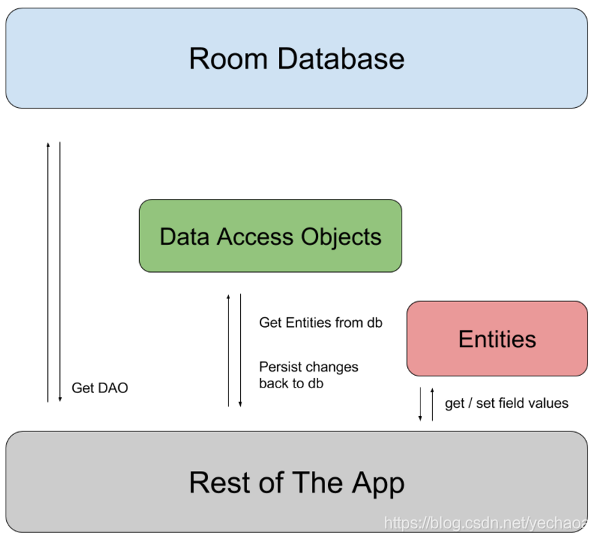本文主要还是参考官方文档,然后以保存搜索历史为例操作一波。
准备工作
Room 在 SQLite 上提供了一个抽象层,以便在充分利用 SQLite 的强大功能的同时,能够流畅地访问数据库。
依赖
如需在应用中使用 Room,请将以下依赖项添加到应用的 build.gradle 文件。
dependencies { def room_version = "2.2.5"
implementation "androidx.room:room-runtime:$room_version" kapt "androidx.room:room-compiler:$room_version"
// optional - Kotlin Extensions and Coroutines support for Room implementation "androidx.room:room-ktx:$room_version"
// optional - Test helpers testImplementation "androidx.room:room-testing:$room_version"}
复制代码
主要组件
应用使用 Room 数据库来获取与该数据库关联的数据访问对象 (DAO)。然后,应用使用每个 DAO 从数据库中获取实体,然后再将对这些实体的所有更改保存回数据库中。 最后,应用使用实体来获取和设置与数据库中的表列相对应的值。
关系如图:
ok,基本概念了解之后,看一下具体是怎么搞的。
Entity
@Entity(tableName = "t_history")data class History(
/** * @PrimaryKey主键,autoGenerate = true 自增 * @ColumnInfo 列 ,typeAffinity 字段类型 * @Ignore 忽略 */
@PrimaryKey(autoGenerate = true) @ColumnInfo(name = "id", typeAffinity = ColumnInfo.INTEGER) val id: Int? = null,
@ColumnInfo(name = "name", typeAffinity = ColumnInfo.TEXT) val name: String?,
@ColumnInfo(name = "insert_time", typeAffinity = ColumnInfo.TEXT) val insertTime: String?,
@ColumnInfo(name = "type", typeAffinity = ColumnInfo.INTEGER) val type: Int = 1)
复制代码
Entity 对象对应一张表,使用@Entity注解,并声明你的表名即可
@PrimaryKey 主键,autoGenerate = true 自增
@ColumnInfo 列,并声明列名 ,typeAffinity 字段类型
@Ignore 声明忽略的对象
很简单的一张表,主要是name和insertTime字段。
DAO
@Daointerface HistoryDao {
//按类型 查询所有搜索历史 @Query("SELECT * FROM t_history WHERE type=:type") fun getAll(type: Int = 1): Flow<List<History>>
@ExperimentalCoroutinesApi fun getAllDistinctUntilChanged() = getAll().distinctUntilChanged()
//添加一条搜索历史 @Insert fun insert(history: History)
//删除一条搜索历史 @Delete fun delete(history: History)
//更新一条搜索历史 @Update fun update(history: History)
//根据id 删除一条搜索历史 @Query("DELETE FROM t_history WHERE id = :id") fun deleteByID(id: Int)
//删除所有搜索历史 @Query("DELETE FROM t_history") fun deleteAll()}
复制代码
@Insert:增
@Delete:删
@Update:改
@Query:查
这里有一个点需要注意的,就是查询所有搜索历史返回的集合我用Flow修饰了。
只要是数据库中的任意一个数据有更新,无论是哪一行数据的更改,那就重新执行 query 操作并再次派发 Flow。
同样道理,如果一个不相关的数据更新时,Flow 也会被派发,会收到与之前相同的数据。
这是因为 SQLite 数据库的内容更新通知功能是以表 (Table) 数据为单位,而不是以行 (Row) 数据为单位,因此只要是表中的数据有更新,它就触发内容更新通知。Room 不知道表中有更新的数据是哪一个,因此它会重新触发 DAO 中定义的 query 操作。您可以使用 Flow 的操作符,比如 distinctUntilChanged 来确保只有在当您关心的数据有更新时才会收到通知。
//按类型 查询所有搜索历史 @Query("SELECT * FROM t_history WHERE type=:type") fun getAll(type: Int = 1): Flow<List<History>>
@ExperimentalCoroutinesApi fun getAllDistinctUntilChanged() = getAll().distinctUntilChanged()
复制代码
数据库
@Database(entities = [History::class], version = 1)abstract class HistoryDatabase : RoomDatabase() {
abstract fun historyDao(): HistoryDao
companion object { private const val DATABASE_NAME = "history.db" private lateinit var mPersonDatabase: HistoryDatabase
//注意:如果您的应用在单个进程中运行,在实例化 AppDatabase 对象时应遵循单例设计模式。 //每个 RoomDatabase 实例的成本相当高,而您几乎不需要在单个进程中访问多个实例 fun getInstance(context: Context): HistoryDatabase { if (!this::mPersonDatabase.isInitialized) { //创建的数据库的实例 mPersonDatabase = Room.databaseBuilder( context.applicationContext, HistoryDatabase::class.java, DATABASE_NAME ).build() } return mPersonDatabase } }
}
复制代码
使用@Database注解声明
entities 数组,对应此数据库中的所有表
version 数据库版本号
注意:
如果您的应用在单个进程中运行,在实例化 AppDatabase 对象时应遵循单例设计模式。 每个 RoomDatabase 实例的成本相当高,而您几乎不需要在单个进程中访问多个实例。
使用
在需要的地方获取数据库
mHistoryDao = HistoryDatabase.getInstance(this).historyDao()
复制代码
获取搜索历史
private fun getSearchHistory() { MainScope().launch(Dispatchers.IO) { mHistoryDao.getAll().collect { withContext(Dispatchers.Main){ //更新ui } } } }
复制代码
collect 是Flow获取数据的方式,并不是唯一方式,可以查看文档。
为什么放在协程里面呢,因为数据库的操作是费时的,而协程可以轻松的指定线程,这样不阻塞UI线程。
查看 Flow 源码也发现,Flow 是协程包下的
package kotlinx.coroutines.flow
复制代码
以 collect 为例,也是被suspend 修饰的,既然支持挂起,那配合协程岂不美哉。
@InternalCoroutinesApi public suspend fun collect(collector: FlowCollector<T>)
复制代码
保存搜索记录
private fun saveSearchHistory(text: String) { MainScope().launch(Dispatchers.IO) { mHistoryDao.insert(History(null, text, DateUtils.longToString(System.currentTimeMillis()))) } }
复制代码
清空本地历史
private fun cleanHistory() { MainScope().launch(Dispatchers.IO) { mHistoryDao.deleteAll() } }
复制代码
作者:https://blog.csdn.net/yechaoa
数据库升级
数据库升级是一个重要的操作,毕竟可能会造成数据丢失,也是很严重的问题。
Room 通过Migration类来执行升级的操作,我们只要告诉Migration类改了什么就行,比如新增字段或表。
定义 Migration 类
/** * 数据库版本 1->2 t_history表格新增了updateTime列 */ private val MIGRATION_1_2: Migration = object : Migration(1, 2) { override fun migrate(database: SupportSQLiteDatabase) { database.execSQL("ALTER TABLE t_history ADD COLUMN updateTime String") } } /** * 数据库版本 2->3 新增label表 */ private val MIGRATION_2_3: Migration = object : Migration(2, 3) { override fun migrate(database: SupportSQLiteDatabase) { database.execSQL("CREATE TABLE IF NOT EXISTS `t_label` (`id` INTEGER PRIMARY KEY autoincrement, `name` TEXT)") } }
复制代码
Migration接收两个参数:
startVersion 旧版本
endVersion 新版本
通知数据库更新
mPersonDatabase = Room.databaseBuilder( context.applicationContext, HistoryDatabase::class.java, DATABASE_NAME ).addMigrations(MIGRATION_1_2, MIGRATION_2_3) .build()
复制代码
完整代码
@Database(entities = [History::class, Label::class], version = 3)abstract class HistoryDatabase : RoomDatabase() {
abstract fun historyDao(): HistoryDao
companion object { private const val DATABASE_NAME = "history.db" private lateinit var mPersonDatabase: HistoryDatabase
fun getInstance(context: Context): HistoryDatabase { if (!this::mPersonDatabase.isInitialized) { //创建的数据库的实例 mPersonDatabase = Room.databaseBuilder( context.applicationContext, HistoryDatabase::class.java, DATABASE_NAME ).addMigrations(MIGRATION_1_2, MIGRATION_2_3) .build() } return mPersonDatabase }
/** * 数据库版本 1->2 t_history表格新增了updateTime列 */ private val MIGRATION_1_2: Migration = object : Migration(1, 2) { override fun migrate(database: SupportSQLiteDatabase) { database.execSQL("ALTER TABLE t_history ADD COLUMN updateTime String") } }
/** * 数据库版本 2->3 新增label表 */ private val MIGRATION_2_3: Migration = object : Migration(2, 3) { override fun migrate(database: SupportSQLiteDatabase) { database.execSQL("CREATE TABLE IF NOT EXISTS `t_label` (`id` INTEGER PRIMARY KEY autoincrement, `name` TEXT)") } } }
}
复制代码
注意:@Database注解中版本号的更改,如果是新增表的话,entities 参数里也要添加上。
建议升级操作顺序
修改版本号 -> 添加 Migration -> 添加给 databaseBuilder
配置编译器选项
Room 具有以下注解处理器选项:
room.schemaLocation:配置并启用将数据库架构导出到给定目录中的 JSON 文件的功能。如需了解详情,请参阅 Room 迁移。
room.incremental:启用 Gradle 增量注释处理器。
room.expandProjection:配置 Room 以重写查询,使其顶部星形投影在展开后仅包含 DAO 方法返回类型中定义的列。
android { ... defaultConfig { ... javaCompileOptions { annotationProcessorOptions { arguments += [ "room.schemaLocation":"$projectDir/schemas".toString(), "room.incremental":"true", "room.expandProjection":"true"] } } }}
复制代码
配置好之后,编译运行,module 文件夹下会生成一个schemas文件夹,其下有一个json文件,里面包含数据库的基本信息。
{ "formatVersion": 1, "database": { "version": 1, "identityHash": "xxx", "entities": [ { "tableName": "t_history", "createSql": "CREATE TABLE IF NOT EXISTS `${TABLE_NAME}` (`id` INTEGER PRIMARY KEY AUTOINCREMENT, `name` TEXT, `insert_time` TEXT, `type` INTEGER NOT NULL)", "fields": [ { "fieldPath": "id", "columnName": "id", "affinity": "INTEGER", "notNull": false }, { "fieldPath": "name", "columnName": "name", "affinity": "TEXT", "notNull": false }, { "fieldPath": "insertTime", "columnName": "insert_time", "affinity": "TEXT", "notNull": false }, { "fieldPath": "type", "columnName": "type", "affinity": "INTEGER", "notNull": true } ], "primaryKey": { "columnNames": [ "id" ], "autoGenerate": true }, "indices": [], "foreignKeys": [] } ], "views": [], "setupQueries": [ "CREATE TABLE IF NOT EXISTS room_master_table (id INTEGER PRIMARY KEY,identity_hash TEXT)", "INSERT OR REPLACE INTO room_master_table (id,identity_hash) VALUES(42, 'xxx')" ] }}
复制代码
ok,基本使用讲解完了,如果对你有用,点个赞呗 ^ _ ^
参考












评论